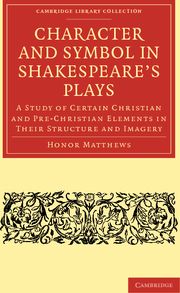 Character and Symbol in Shakespeare's Plays
Character and Symbol in Shakespeare's Plays Published online by Cambridge University Press: 07 September 2010
The preceding analysis has, it is hoped, demonstrated that while the final plays include much that is traditional in Shakespeare's work, the sources of their dynamism must also be sought in new country. The tap-root of the dramatist's imagination appears to be feeling its way towards deeper strata of association, until at last the familiar struggle between justice and mercy is reflected afresh in the imagery of a pagan world, and a new—or it may be a more ancient —conclusion is voiced.
The Christian Church, in spite of its great seasonal festivals, has never made extensive use of seasonal imagery, and in as far as it does so its central symbol is the child born in mid-winter—‘a thing of pity’—rather than the man risen in the spring. But although such material had only a small place in Christian thought and therefore in medieval written drama, it had of course existed in dramatic or semi-dramatic form from time immemorial—as indeed it still exists today in plays of St George and of the Hobby-Horse, the Revesby Sword Play, the Furry Dance of Helston and countless other local celebrations. The May games, already noticed in connection with the symbol of Birnam Wood, made an underground connection with the figure of Robin Hood, and probably the earliest secular written drama in English is the fragment concerning Robin Hood and the Sheriff of Nottingham. Robin and Maid Marian are associated with the king and queen of the May by the version of Robin Hood and the Potter, printed in 1560 under the rubric: ‘Here beginnethe the plays of Robin Hoode, verye proper to be played in May Games.’
To save this book to your Kindle, first ensure [email protected] is added to your Approved Personal Document E-mail List under your Personal Document Settings on the Manage Your Content and Devices page of your Amazon account. Then enter the ‘name’ part of your Kindle email address below. Find out more about saving to your Kindle.
Note you can select to save to either the @free.kindle.com or @kindle.com variations. ‘@free.kindle.com’ emails are free but can only be saved to your device when it is connected to wi-fi. ‘@kindle.com’ emails can be delivered even when you are not connected to wi-fi, but note that service fees apply.
Find out more about the Kindle Personal Document Service.
To save content items to your account, please confirm that you agree to abide by our usage policies. If this is the first time you use this feature, you will be asked to authorise Cambridge Core to connect with your account. Find out more about saving content to Dropbox.
To save content items to your account, please confirm that you agree to abide by our usage policies. If this is the first time you use this feature, you will be asked to authorise Cambridge Core to connect with your account. Find out more about saving content to Google Drive.